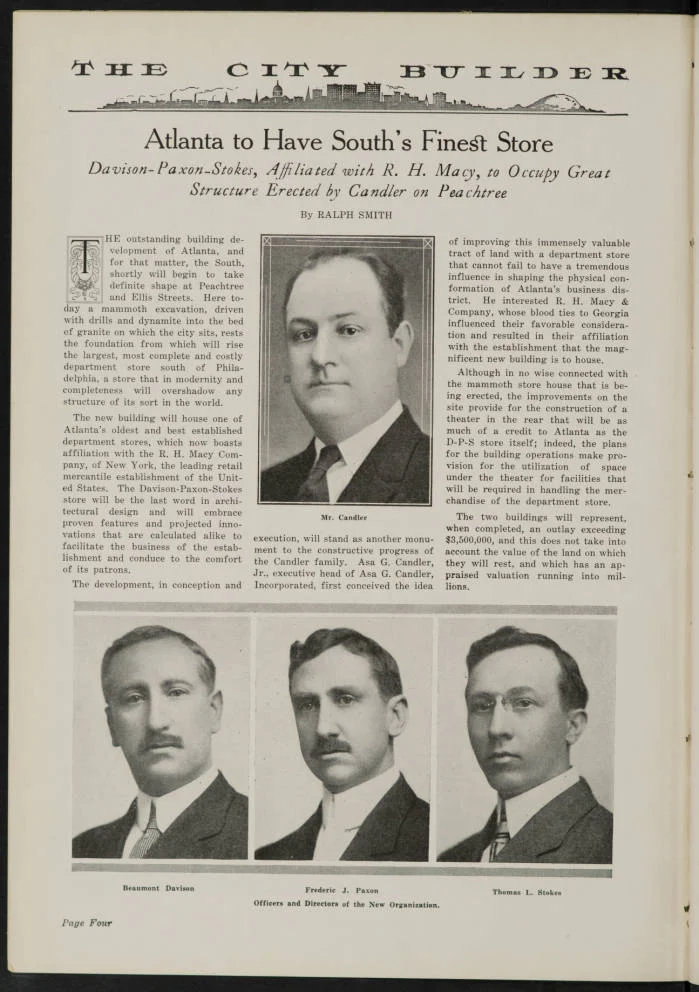Above: A 1940s view of Briarcliff Mansion’s front and side lawn, featuring the formal garden.
We now enter the most visible and infamous period of Buddie’s life. There’s only one way to tackle this period, and that’s by going chronologically year by year. Many events that arise during these years will have dedicated pages elsewhere on the site in future updates, and crosslinks will be provided where appropriate.
1920:
In 1920 Buddie and Helen blossomed into socialites. They spent much of the time that their mansion was under construction traveling around the Gulf in their luxury yacht, the Helasa. The Helasa was a blend of their names, Helen and Asa. They hosted parties at their pool when the grounds were ready, even though the interior of the house was still incomplete.
1921:
Buddie met Harry Houdini and leased office space to him in his father’s New York Candler Building. In his later years he told friends and family that Houdini taught him a card trick and that they were good friends. Whether or not either of these claims is true is subject to debate.
1922:
In 1922 Asa Candler, Jr., celebrated the opening of Briarcliff Mansion, named for his beloved Lozier Briarcliff. He had already invited journalists out to tour the grounds in 1921, showing off the lighted formal garden, the family pool, the greenhouses, and more. The paper dubbed it “40 Acres of Fairyland.” Similar to the press tour he hosted at the incomplete Atlanta Speedway, he ensured that the city was buzzing about his property before it was ready for its debut.
Details about Briarcliff’s construction and amenities can be found here.
Right away he made his home a site for public and private gatherings, a place where any activity was worth a mention in the society pages. Helen hosted high teas and the rotary club, and Buddie hosted pool parties and dinners. Over the years he revised the property again and again, adding a golf course, tennis courts, a mini-farm, a public pool, the now-infamous zoo, and a laundry facility. I’ve found references to fish farming on the property as well. The largest update to the house itself was the music hall, a public performance space that housed the largest Aeolian pipe organ in Georgia. Eighth largest Aeolian ever built, so he claimed. On the top floor of the mansion he framed out a gold-leaf detailed ballroom, where he started amassing a world-class collection of magic apparatuses.
Meanwhile, he continued to make real estate deals, large and small. Mostly large. He aimed for superlatives again, always trying to build the largest hotels or the most innovative warehouse spaces. It was during this time that he got the bright idea to launch the Candler Floating School, a prep school for rich boys that would sail the seven seas (more to come in a later site update). He also fought extortionists.
In 1918 he had helped Asa Sr. battle a trumped up lawsuit coordinated by J. W. “Handsome Bill” Cook and Mrs. H. H. Hirsch, who set up the city’s mayor in a he-said-she-said indecency claim. In 1922 a New Orleans divorcee named Ms. Onezima De Bouchele accused Asa, Sr., of breaking a promise to marry her and sued for breach of contract. Also in 1922 a man named Clyde Byfield and his wife accused Walter—probably truthfully in this case—of sexually assaulting Mrs. Byfield and trying to pay them hush money. Buddie was involved in all three of these episodes. He also faced his own extortionists, from fake Coca Cola investors to identity theives, and even one plot to blow up his zoo. More on the extortionists that targeted the Candlers in the 1920s and 30s will be included in a future site update.
1923:
In 1923 his floating school went belly-up, but it hardly mattered because by then he’d moved onto his next interest: the Shriners. He purchased a private railcar and used it to ferry around high ranking members of the Shriner’s organization and became involved in the funding and planning of the fabulous Fox Theater, which still stands in downtown Atlanta today.
In January it was time for Lucy III to make her debut, so he threw major funding behind the party planning, which filled the house to overflowing with exotic orchids and featured a guest list fit for a coronation. He intentionally outshined his sister Lucy’s party that she threw for her daughter Elizabeth’s debut. His daughter debuted to rave reviews in the society pages, and he went on record declaring that there were too few eligible bachelors in Atlanta, eligibility being defined as belonging to two socially elite clubs and owning at least one car. Then in July Lucy became engaged to Homer Thompson, a young man who definitely didn’t fit the definition. No matter, Buddie built a second solarium, erected a giant tent, and threw a soiree like Atlanta had never seen. The night of the reception Lucy and Homer slipped out to escape for their honeymoon, startled a neighbor, and they were nearly struck by bullets when that neighbor shot at them in the darkness.
In June Asa, Sr., married a woman half his age, possibly to shut down the legal claims of Ms. De Bouchele. Just a few months later the new Mrs. Candler was arrested for drinking in a dive, one of whom was Buddie’s close friend Bill Stoddard. Mrs. Candler had her day in court and sheepishly returned home to her husband, who kept her at arm’s distance after that.
During this time Buddie was expanding his warehouse interests, making arrangements to close the largest stockyard purchase in the US, and became embroiled in lease disputes with more than one tenant. He formulated a plan to bring an enormous Macy’s store to downtown Atlanta. And he broke ground on the Briarcliff Hotel and Apartments, a luxury space that he would eventually call home.
1924:
In 1924 he personally leased the old Atlanta Speedway land to the City of Atlanta for five years, provided they paid the taxes and assessments. Future mayor William Hartsfield himself inspected the grounds and agreed to the offering, which would eventually become what is today known as Hartsfield-Jackson Airport. He also invested and created the largest cotton warehouse and compress system in the Southeast, he purchased a stockyard and turned into the largest operation of its kind in the southeast, and he invested in an industrial film production company called Graphic Films Corporation. And he laid the groundwork to break ground on the first Macy’s in the southeast.
1925:
In 1925 he decided to add a music hall to his mansion and left for a tour through a few Eastern Asian countries to escape the hubbub. During his time in the Philippines, he encountered a young magician named José Cruz. Whatever José Cruz offered must have impressed him, because Buddie made arrangements for José to immigrate to America to be his personal butler and magic teacher.
In 1925 the Shriners’ work on the new Yaraab Temple, later the Fox Theater, began in earnest. Also in 1925 the Atlanta Constitution reported that Buddie and Walter together owned approximately $30mm in property along Peachtree St., Atlanta’s busiest corridor. Lastly, he ended up in the papers for possessing illegally smuggled pearls.
1926:
In 1926 Buddie and Helen’s first grandchild was born to Lucy III. He also ramped up his activities with the Shriners, hobnobbing with the top ranking officers and ferrying them around the country to various Shriner gatherings in his private railcar. He also broke ground on a large new theater named The Capitol, which was adjacent to the new Macy’s/Davidson’s store.
Also in 1926, Asa, Sr., suffered a debilitating stroke that kept him bed-ridden in a hospital for the next three years.
1927:
In 1927 Helen passed away.
Ten months later Buddie married his stenographer.
He sold the yacht named Helasa and replaced it with a more palatial one named the Amphitrite. He and Florence took to the seas and traveled in earnest over the next couple of years, and he threw himself headlong into magic. He even had José teach his son Samuel how to perform magic. Meanwhile his Macy’s/Davidson’s store and The Capitol Theater opened in the spring and early summer.
1928:
In 1928 Buddie and José traveled via private railcar to magic competitions so Sam could show off his skills. Buddie started bailing out of investments and sold off his cotton warehouse and compress system, announced that he was getting out of the stockyard business, shuttered the film production company, and he finally offloaded the Speedway land for good, selling Candler Airfield for $100k to the city.
He also gained some notoriety for the coast guard finding illegal booze stashed on his yacht on a return trip from Cuba, which may have been a costly legal event that precipitated the great sell-off of interests listed in the previous paragraph. More about illegal booze to come in a future update.
1929:
In March of 1929 Asa, Sr., passed away. Buddie was traveling in Egypt and the Mediterranean at the time.
In April he finally closed the airfield sale and the land officially changed ownership. It’s worth noting this order of events, because most histories of the Atlanta airport erroneously credit Asa, Sr., for the sale. But Asa, Sr., suffered a stroke in 1927 and spent much of the next two years incapacitated, in and out of comas. He could not have made the business decisions that led to the sale of the airfield.
In 1929 Buddie added to his growing list of rich men’s hobbies by adding air travel. He purchased an aeroplane and had the word “Briarcliff” painted across the side. Local flying instructor and airmail pro Beeler Blevins was hired to be his pilot on demand. He also bought John and Martha their own planes as gifts.
Buddie lived large in the 1920s, that is certain. But in 1929 the economic sands shifted beneath everyone’s feet when the Stock Market crashed and plunged America into the Great Depression. And while the Candlers mostly weathered the storm without compromising their luxurious lifestyles, Buddie’s extravagance eventually invited some financial struggles that will become evident under scrutiny in the 1930s.
1920s: The Briarcliff Mansion Years pt 1 Gallery
40 Acres of Fairyland
1923 Ad for the Candler Floating School, which was scrapped before its inaugural voyage.
Concept Illustration for the Yaarab Temple Shrine, which would become The Fox Theater.
Advertisement for Graphic Films Corporation, of which Asa Candler, Jr., was a principal investor. April, 1925
Macy’s Store Announcement, The City Builder, December, 1925
The Capitol Theater, located between Atlanta’s first Macy’s (Davidson’s) Store and the Roxy Theater, just up Peachtree from the Candler Building.
The Atlanta Constitution, April 13, 1924
Atlanta’s first Macy’s (Davidson’s) Department Store, The City Buider, July 1926
Mule Market Announcement, The City Builder, September 1924
Candler Airfield Story, The City Builder, OCtober 1926
Helen Candler’s Obituary, February 1, 1927, The Atlanta Constitution
October 15, 1927, The Atlanta Constitution
The City Builder, April, 1929























